Explainer
- Explainer
- Health
Dim light, failing sight: Behind this classic sign of middle-age
The menu looks foggy. The tiny instructions are a blur. It’s that time when your vision, a marvel of evolution, needs some help sharpening up. What’s going on in the eye itself? And what else could possibly go wrong?
It starts in a restaurant. Classy music, dim light. You break from your scintillating conversation to scan the menu. “Hmm, it all looks so good,” you remark. In truth, the tiny font is swimming before your eyes, a trendy blur. You hold the list at arm’s length. Wait, isn’t that what your grandfather used to do? Oh, dear. Would it be uncouth to use the torch on your phone? Hmm. “I’ll have what you’re having,” you say.
Most people can just about set their watch to it: that time of life when the windows to our souls become a little, well, foggy. It’s called presbyopia, a term that shares Greek roots with Presbyterian – “church ruled by elders” – and refers to the affliction of “old sight”. It starts in, yes, middle age. “It’s completely related to how many birthdays you’ve had,” says Lauren Ayton, a principal investigator at the Centre for Eye Research Australia. “It will eventually happen to us all, any time from the age of 45.”
The very fact that we can see at all is, put simply, nothing short of “gobsmackingly amazing”, says Andrew Metha, head of optometry and vision sciences at the University of Melbourne. “It is almost miraculous, but of course, it is the result of millions of years of evolution.” Still, as with anything in our delicate bodies, human vision is prone to problems. Few of us will go through life without needing some help for our vision – nearly half of Australians wear spectacles or contact lenses. Meanwhile, a host of other maladies can affect our sight, including cataracts, the world’s most common preventable eye condition. Around the world, more than 2 billion people have issues with their vision.
How do eyes work? What happens when they don’t? And how can sight be lost and restored?
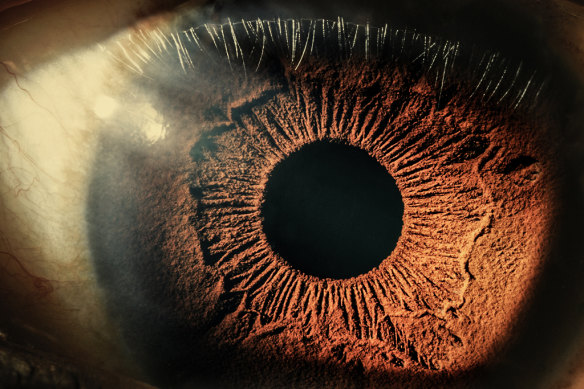
The iris is a muscle, but where does the colour come from?Credit: Getty Images, digitally tinted
First, where did eyes come from?
So exquisitely complex is the eye it’s almost “absurd” to think it could have evolved though natural selection, wrote Charles Darwin in On the Origin of Species in 1859. Still, despite feeling a “cold shudder” at the prospect that the eye could upend his theory, reason told him it didn’t. Today, evolutionary biologist Dan-Eric Nilsson tells us from Sweden: “You can basically trace the eyes of all animals back to the Cambrian explosion.”
Some 540 million years ago, two types of eyes emerged. Insects (and crustaceans) have compound eyes; blowflies have about 4000 tiny peepers, known as ommatidia, while dragonflies have 30,000. This gives them a wide field of vision, although each ommatidium is connected to just one “pixel”, which doesn’t add up to particularly high definition.
For our ancestors, the evolutionary solution was different: camera-style eyes. Trevor Lamb, an emeritus professor of neuroscience at the Australian National University, puts it like this: “Basically, there was an arms race. In order to survive, our ancestors had to evolve spatial vision, and they took a quite different approach to those lineages of crustaceans and insects.”
Camera-style eyes focus light on a particular area at the rear of the eye. In jawed vertebrates (that’s us and 60,000 other species, including most fish), this area contains highly sensitive cells known as rods and cones (more on this shortly). Says Lamb: “The fish eye, underwater, is performing pretty much as well as, say, a mouse’s eye in air.”
Why two eyes? Many creatures emerged as bilaterally symmetric in the Cambrian era, says Lamb. “Later, the eyes of some vertebrates moved round to be facing forwards on their head, and they had overlapping fields of view. And if they did have a big enough brain, they were able to evolve depth perception using the disparity between the two images.”
With their eyes to the front, large birds of prey famously have densely packed photoreceptors, so they can spot distant prey two-and-a-half times more sharply than even the most “eagle-eyed” human. As for colour, humans can’t see the ultraviolet light that reptiles, birds and many fish can because the lens in each of our eyes filters out UV. Dogs and cats do struggle to distinguish reds from greens and do indeed have a “mirror”, the tapetum lucidum behind the retina, that helps them see at night with eyes that appear to glow in the dark when spotlighted.
In humans, the fovea – a tiny pit in the centre of the macula in the retina housing hundreds of thousands of densely packed photoreceptors – “gives us almost all of our useful vision,” says Lamb, not least our ability to read and see fine detail. It is just part of an array of extremely delicate parts that operate the “cameras” that give us vision.
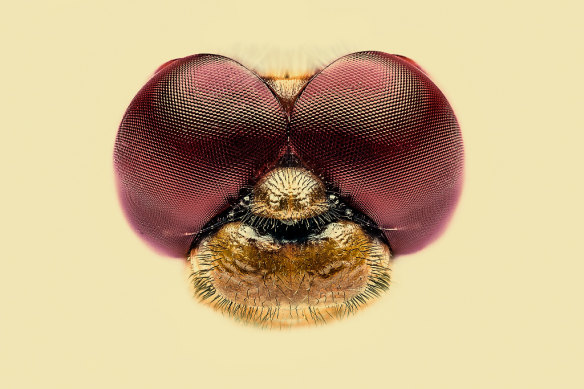
Dragonflies have 30,000 eyes, as seen in this ruddy darter.Credit: Getty Images, digitally tinted
What’s in an eye?
When light, hurtling at 300,000 kilometres a second, reaches our eyes, it first passes through a film of tears – not salty water but a triple band of specific biochemicals that flush away dirt and maintain moisture. We produce enough of this liquid, replenished each time we blink, to fill between one and two buckets a year.
Next, the light moves through the cornea, a transparent dome over the iris and pupil. Light “bends” as it hits the cornea and travels into another fluid, aqueous humour (Latin for fluid, not comedy), which gives the eye its internal pressure. “Your eye is like a football,” says Andrew Metha. “It’s pumped up … Were that not the case, when you tried to move your eyes with the six extraocular muscles connected to your eye, your eye would flop around.” (Glaucoma is when a build-up of aqueous humour increases the pressure on the eye to the point that it damages the optic nerve.)
The iris is a ring of muscle that dilates to control the amount of light entering the pupil (which is a hole). “Red eye” in photographs is caused by light from a sudden camera flash illuminating the blood in the lining of the eyeball. The iris contracts to protect the inner eye against glare and opens to offer support in dim light; it also dilates in response to fear, some medications and even sexual arousal. And every iris is unique, like a fingerprint. Biometric iris scanners use a combination of ordinary light and infrared light to record hundreds of unique points on the iris.
“Iris” is from the Greek for rainbow. Whence the colour? The iris has two layers. One contains the brown pigment melanin. The other, the stroma, sits on top and varies among people. A lot of melanin makes brown eyes (up about 79 per cent of people worldwide, according to a 2020 review in the Journal of Cellular Physiology), and a little melanin makes for hazel (about 5 per cent) or green (2 per cent). In blue eyes (8 to 10 per cent) or grey (2 per cent), the stroma is translucent and light scatters in a phenomenon called the Tyndall Effect, which merely creates the impression of colour. No melanin at all, as in people with albinism, leads to red irises. Fewer than 1 per cent of people (but many more cats and dogs) have mismatched irises, known as heterochromia. Incidentally, rock star David Bowie’s eyes were the same colour, but he had anisocoria, with one pupil permanently dilated, after a fracas (over a girl) when he was a teenager.
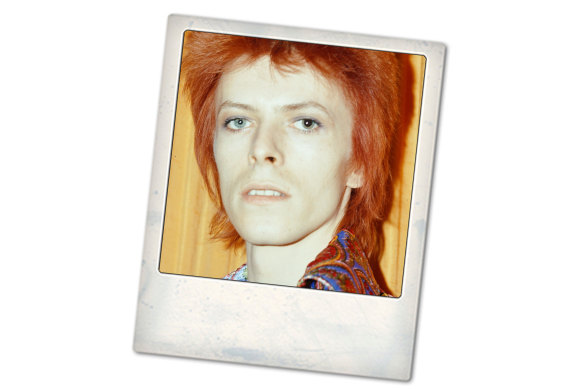
David Bowie in 1973. One of his pupils was permanently dilated.Credit: Getty Images, digitally altered
Behind the iris and pupil is a lens: a lentil-shaped tissue with a crystalline structure that remains transparent even as it changes shape. Tiny muscles pull the lens taut or relax so it becomes “plump”, adjusting the pathway of light that hits the retina. It’s the lens that is ground zero for that pesky problem of presbyopia – over time, it loses its flexibility.
Behind the lens is another humour, a transparent gel called vitreous humour, which makes up about 80 per cent of an eye. “We want the eye to maintain its structure, and it has to be clear so light can get through. It holds together the structural integrity of the eye,” says Lauren Ayton. As we age, the gel can thin, clumping or causing “floaters”. “People think they see hairs or insects in their eye, and it’s because of these little condensations in the jelly,” says Robyn Guymer, deputy director of the Centre for Eye Research Australia.

Something in the air: An artists’ impression of so-called “floaters”.Credit: Getty Images, digitally tinted
But how do we actually see?
At the back of the eye is the retina, a postage-stamp-sized piece of fragile tissue that consumes more oxygen for its size than nearly anywhere else in the body. Cue the camera metaphor: but instead of the light imprinting on film, the retina turns light into an electrical-chemical signal to the brain. Light penetrates 10 layers of retinal tissue to microscopic photoreceptors in the final layer – shaped like rods and cones.
The rod photoreceptors – each eye has about 120 million – cluster at the retina’s edge, helping peripheral vision and sight in low light. “Unfortunately, in some diseases, rod cells become sick and die, and that means people lose their ability to see at night and can end up with tunnel vision as they lose their peripheral vision,” says Ayton.
Some 6 million cone photoreceptors are concentrated in the macula, a spot in the centre of the retina. As well as enabling high-resolution vision, they’re sensitive to colour. Specifically, cones come in three types that sense long, medium or short wavelengths; different colours are on different wavelengths (violet is the shortest, for example, red is the longest). Colourblind people are missing or have inherited anomalies to one or more cone types. “A ripening tomato from when it’s green to very ripe red would look the same to someone who has a red-green colour problem,” Ayton says.
The cones and rods you’re born with are all you get, says Ayton. “They don’t replicate, and they don’t replace over your lifetime.” In Australia, about half of cases of legal blindness result from photoreceptor death. It’s also why we’re encouraged to wear sunglasses. “People who do look directly at the sun sometimes have a black patch in their central vision that we can’t ever restore,” Ayton says. Long before shades were invented, the Roman emperor Nero was said to cut glare by holding an emerald to his eye to watch gladiator contests.
The camera metaphor, again: when light hits the retina, the image is upside-down. The signal then travels into the optic nerve at the back of each eye and onto a region of the brain at the back of the head – the primary visual cortex – where we interpret it. The brain is sometimes thought of as “flipping” the image for us, but Metha prefers to think of it simply as a seamless interpretation. “We’re wired up to reconstruct what is outside in the external world in a way that represents reality.”
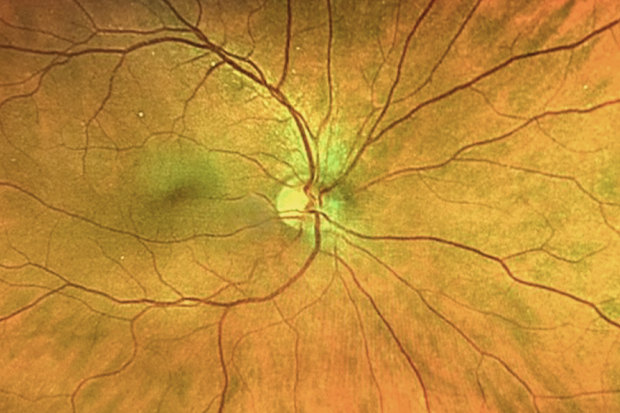
The human retina: End product of millions of years of evolution.Credit: Getty (Digitally tinted)
What causes long and shortsightedness?
In ancient Persia, people would use the constellations of stars to test eyesight. One test involved pinpointing Mizar and Alcor, which could be mistaken for one star in the Big Dipper. In about 350 BCE, Aristotle determined there was such a thing as “average” vision – clearly seeing distant objects in detail – which people fell either side of. In 1862, Dutch ophthalmologist Herman Snellen developed the standard method for testing eyesight – a chart with rows of capital letters of diminishing size – which the British Army adopted.
A person stands 20 feet (six metres) from the chart. The reproduction below isn’t for medical use, as the letters will appear at different sizes on various devices, it’s just to give you the gist. The 20/20 line, if you can read it, means you have the vision of the average person reading from 20 feet away, hence “20/20 vision”. If you can make out the letters in the 20/15 row, your vision is sharper than average. If you can only make out the 20/40 line, your vision is worse than average: you can read at 20 feet what the average person can read at 40 feet (12 metres). A person is legally blind if they can’t read the top line with glasses on.
Several of the most common issues with our vision occur when the shape of the eye prevents light from focusing directly on the retina. They’re called refractive errors. Hyperopia, or longsightedness, which affects 7.2 million Australians, is when the eyeball grows too short from front to back and stops light from close objects bending as it should to hit the retina, causing anything close to appear blurry. In shortsightedness or myopia, distant objects blur because the eye grows too long and causes light to fall short of the retina. “Myopia only happens when you’re growing; your eyeball grows when you grow,” says Robyn Guymer. “So by the time you’re in your mid-20s, if it hasn’t happened, you don’t get myopia.”
In Australia, 6.3 million people suffer from myopia. Genetics play a role: having one myopic parent doubles someone’s chances. Lifestyle also contributes, although to what extent is difficult to pin down. One school of thought says fixating on screens at a young age causes the eye to lengthen to adapt. Another posits that not getting enough sunlight affects the eye’s ability to regulate its growth. Says Lauren Ayton: “These things overlap, so it’s really hard to work out what is the actual cause; is it that you’re on a computer so you’re not outside enough?”
In China, rates of myopia have surged to affect more than 80 per cent of young people. In 2018, President Xi Jinping said myopia “seriously affects” students’ physical and mental health. “This is a major issue for the future of the country and citizens, it must be taken seriously and not allowed to develop further.” His government encouraged children to spend at least two hours a day outdoors.
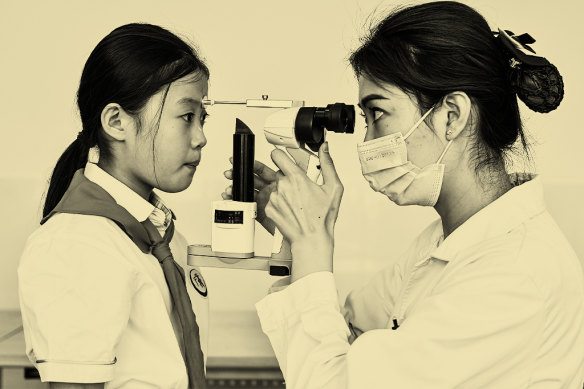
A student has her eyesight tested in east China’s Shandong province in 2023. Xi Jinping has vowed to combat widespread myopia. Credit: Getty Images, digitally tinted
Living in a daily blur due to a mild case of myopia or hyperopia can be addressed with spectacles or contact lenses, which alter the direction of light as it enters the eye. The more correction required, generally, the thicker the lens gets. “If we didn’t have glasses, most people would be vision impaired,” notes Ayton. “They’re something we take for granted.”
One misnomer is that wearing glasses can worsen eyesight. “Glasses can’t cause you to need glasses,” says Guymer. What worries eye specialists is if myopia leads to a more serious eye disease, which regular optometry visits can test for. In severe cases, myopic eyes can grow so long that they cause the retina to tear or even detach.
What are macular degeneration and cataracts?
The retina is also ground zero for the most common cause of blindness in older people: age-related macular degeneration. One in seven Australians over 55 shows some sign of the disease and this increases to a quarter of people by 80, says Guymer, an expert in the condition. For up to 2 per cent of the population, it progresses to threatening their vision. The disease creates a fatty deposit in the retina that reduces blood supply and causes photoreceptors to die. “Bits of the vision go missing. I call it like moth-eaten holes in the retina,” says Guymer.
Given not everyone with macular degeneration ends up with vision impairment, practitioners can give people a take-home test, called an Amsler grid, that people can use to self-monitor daily changes in their eye health. If the grid appears wavy or distorted, it’s possible the person has wet macular degeneration, which is when the body creates new blood vessels at the back of the eye to address the disease, but they go rogue and damage the retina. If doctors catch it early enough, injections can stop the damage. “Most people will end up having injections every two to four months for many years, if not their life,” says Guymer.

Claude Monet in 1899. His struggle with cataracts was a “torture”.Credit: Getty Images
Surgery to remove cataracts is the most common elective surgery in Australia, accounting for 10 per cent of procedures in 2022–23. “If you live long enough, you’ll get cataracts,” says Ayton. Protein in the lens is damaged and clumps together, causing the person’s vision to cloud. “It’s like having fingerprints on the lens of your camera.” Impressionist painter Claude Monet, famous for his studies of colour and light, also famously developed cataracts in his 60s, complaining that he was making “bad paintings … when seeing nothing but fog”.
After years of resisting, he agreed to an operation on one eye in 1923, with complications prompting a follow-up procedure, after which he complained of seeing “nothing but blue”. (“I no longer see red or yellow,“ he told his doctor. “This annoys me terribly because I know these colours exist.” ) New spectacles with a yellow-green tint helped, and he worked on his waterlily paintings for the French government before dying, at 86, in 1926. Unlike in Monet’s day, modern surgeons implant an artificial lens to replace the cloudy one. Says Ayton: “The catch is that plastic [rigid] lenses can’t change focus, so generally, as soon as you have cataract surgery, you’ll need reading glasses.”
What’s a bionic eye?
In primary school, Sefa Kuzu would scrunch up his eyes to see the board or read a book. The world became foggier over time. The cause came into focus in his late teens: a rare eye disease, retinitis pigmentosa, was making him blind. “One year you can see a doorknob, the next you’ve got to go really close up to see it,” Kuzu says. “To see faces, you have to be even closer. Then, after a while, you can’t see the faces.”
In his 40s, Kuzu moved with his wife and daughter from the country town of Mildura to Melbourne, where there was family support. The city was a labyrinth of crossings and crowds, and he had no mental map as he did for the town he grew up in. “I started bumping into stuff, hitting my head,” he says. His house was the only place he came to know. In 2017, his cousin, a theatre technician at the Royal Victorian Eye and Ear Hospital in Melbourne, was working with a doctor who was looking for patients with Kuzu’s condition to try out a “bionic” eye. “I was over the moon,” he says. “There was a possibility I could maybe have some vision again.”
Now 53, Kuzu wears glasses with camera lenses that detect shapes and objects and send a signal to a hand-held device and then to a magnet sensor connected to his scalp, similar to a cochlear ear implant. From the sensor, the message travels to receivers implanted behind his ear and under the skin to the back of one of his eyes, where another implant stimulates the retina. When Kuzu looks at an object, the message from the cameras causes him to see flashes of light.
Unlike the ’70s TV show The Six Million Dollar Man, in which Colonel Steve Austin zooms in on faraway action to a beep-beep-beep sound effect, modern bionic eyes are more nuanced. The flashes in Kuzu’s sight indicate the edges and outlines of objects. “In the past, you might run into a car sitting in a driveway. But when you’ve got the device, you know something is there,” he says. “It’s changed my life; when you’re eating, you can see the fork, the plate, the glass.”
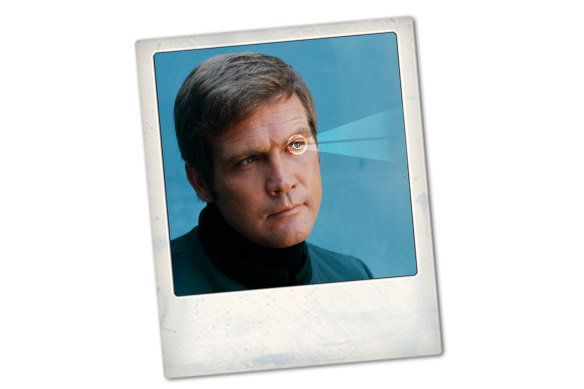
Bionic man and 1970s school playground fixture Steve Austin.Credit: Getty
Still, the bionic eye, implanted in only seven Australians, is a long way from perfect. “You’ve got to use your brain. You have to work out what the object is,” says Kuzu. His bionic eye was inserted by Penny Allen, head of the vitreoretinal unit at the Royal Victorian Eye and Ear Hospital, who says the device offers a “sense of vision”, not restored eyesight. “At the moment, it doesn’t offer complete independence, but it is an additional aid to sensing the environment,” she says.
Surgery on the retina is incredibly finicky work for which specialists do an additional two years of training. “We use a microscope pretty much all the time. And sometimes, we peel little bits of scar tissue from the surface of the retina. It’s very delicate surgery,” she says.
Kuzu has found work for the first time after going blind, preparing food in a restaurant. And for the first time, he can walk with confidence around his suburb, including along the Maribyrnong River. He’s even found a silver lining to his eyesight problems – his hearing has become “very sensitive”. “I go camping a lot. I can hear everything. The beach: if I’m 100 metres away, I can hear the waves.”
With Cindy Yin
Get fascinating insights and explanations on the world’s most perplexing topics. Sign up for our weekly Explainer newsletter.
Let us explain
If you'd like some expert background on an issue or a news event, drop us a line at explainers@smh.com.au or explainers@theage.com.au. Read more explainers here.